How Proposal Software Enhances Client Onboarding
Learn how to automate tasks, reduce errors, and personalize the process, all while saving valuable time.
— Propoze

Proposal software has completely transformed client onboarding by automating tedious tasks, simplifying document collection, and seamlessly integrating with CRM systems.
The result?
A faster, more personalized onboarding experience that’s less prone to errors.
In this post, we’ll dive into how proposal software enhances client onboarding, helping you save time, reduce mistakes, and deliver a smoother, more professional experience for your clients.
Keep reading to discover the tools and strategies that can streamline your onboarding process.
How automated onboarding workflows save time and reduce errors
One of the biggest benefits of using proposal software in the onboarding process is the automation of workflows. Traditional onboarding can involve a lot of repetitive tasks—like gathering client information, sending reminders, and managing document approvals. Proposal software streamlines these steps, automating much of the work that would otherwise take up valuable time.
How does it save time?
By automating document collection, reminders, and follow-ups, proposal software reduces the need for manual interventions. Tasks that used to take hours or even days—such as preparing proposals, getting documents signed, or tracking down missing client information—can now be completed in minutes. The software sends automated notifications to clients and internal teams, ensuring that no steps are overlooked.
How does it reduce errors?
Manual onboarding processes often lead to mistakes, from misfiled documents to incorrect client data. Proposal software eliminates these errors by automatically pulling in data from integrated CRMs and keeping everything organized. With predefined templates and workflows, there's less chance of human error, and the whole process becomes more consistent and reliable.

Unfortunately, as seen above, it seems that sales and proposal automation is still lagging behind.
Still, we can confidently say — automated onboarding workflows improve efficiency and allow businesses to onboard clients more smoothly while providing a more professional and seamless experience.
But there's more to it. Let's go into the details.
1) Streamlining document collection and approvals
Proposal software eliminates many of the bottlenecks that come with manual document management, making the process faster and more efficient.
- Automated document requests: Predefined workflows automatically send out document requests at the right time, ensuring clients receive timely prompts to submit the necessary materials.
- Real-time tracking and status updates: Keep track of submitted, pending, or approved documents in one place with live updates. This helps everyone involved stay on the same page, preventing delays and confusion.
- Automated reminders: No more manual follow-ups for missing documents. The software sends automated reminders to clients, ensuring deadlines are met without repeated manual effort.
- Efficient approvals: Once a document is submitted, internal teams or managers are automatically notified for review and approval. This ensures faster feedback, helping to keep the onboarding process moving forward.
With documents flowing smoothly through automation, the time saved in the collection and approval process helps teams shift their focus to client communication and relationship-building.
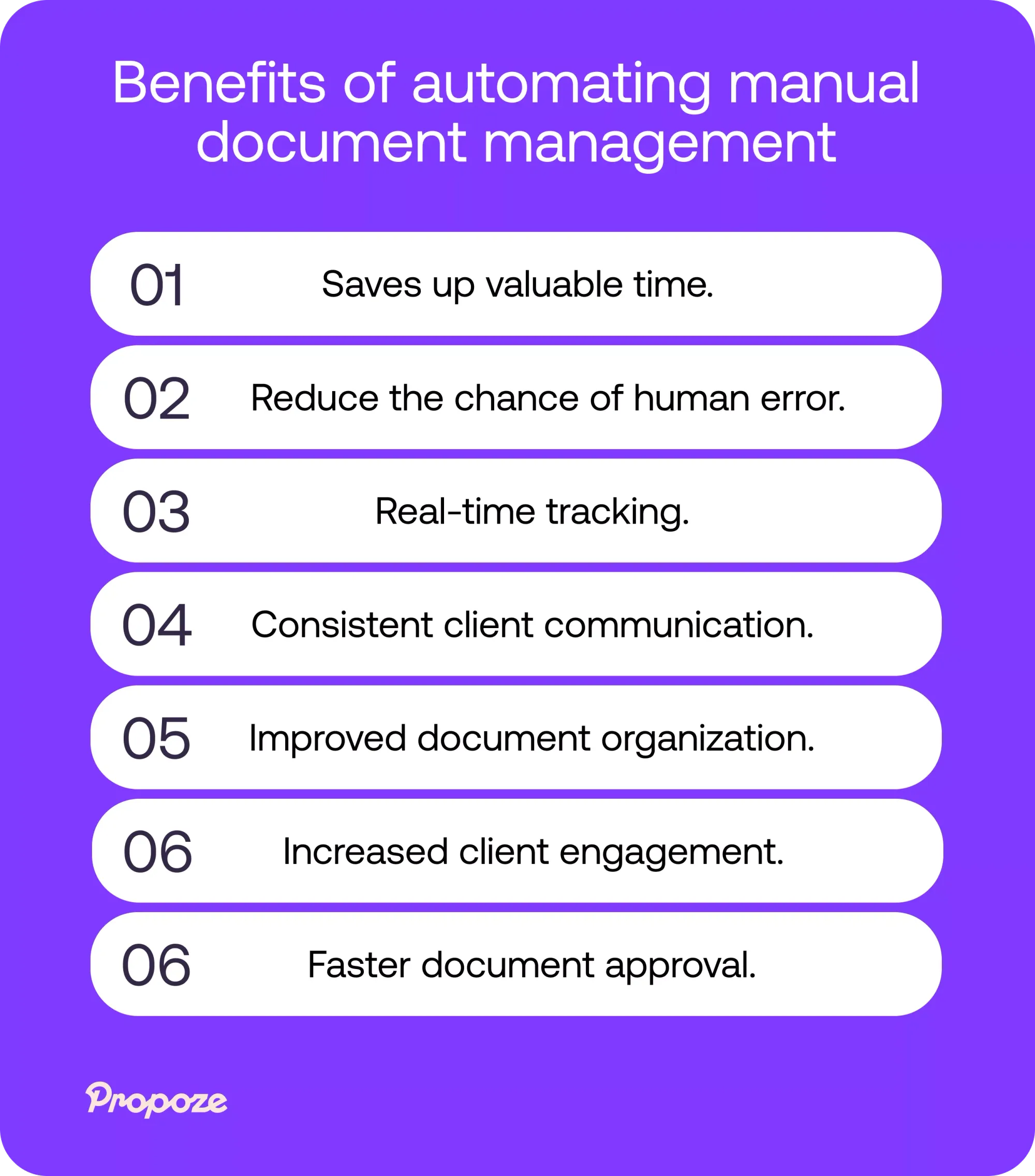
Now, let’s look at how automated follow-ups ensure nothing is overlooked during the onboarding process.
2) Automating follow-ups and client reminders
Managing follow-ups and reminders manually can be time-consuming and prone to delays.
With proposal software, these tasks are automated, ensuring that every client interaction happens on time, without requiring constant attention from your team.
Here's why automating follow-ups is THE way to go:
- Scheduled follow-ups: Proposal software allows you to set predefined follow-up intervals, ensuring clients receive timely emails or notifications regarding the next steps in the onboarding process. This keeps clients engaged without any manual intervention.
- Automated client reminders: Whether it's reminding clients about upcoming meetings, document submissions, or signatures, proposal software automatically sends personalized reminders. These reminders keep clients on track and reduce the likelihood of missed deadlines.
- Consistency across clients: Automation ensures that every client receives consistent communication, avoiding situations where one client might be forgotten while another gets extra attention. This helps provide a uniform and professional experience for all clients.
- Multiple communication channels: Many proposal software platforms support follow-ups and reminders across multiple channels, such as email, text, or even app notifications. This ensures that reminders are delivered in a way that suits the client's preferences, boosting engagement and compliance.
By automating follow-ups and client reminders, you create a reliable communication system that ensures clients stay informed and deadlines are met, keeping the onboarding process smooth and predictable.
The automated reminders also foster a sense of professionalism and reliability, which helps to build trust early in the client relationship.
As the follow-up process is streamlined, it works hand-in-hand with proposal software's integration into CRM platforms, which further enriches the onboarding experience by centralizing all client data.
CRM integration provides a seamless onboarding experience
Proposal software integrated with your CRM system brings the efficiency of a seamless onboarding process to new heights.
If CRM integration makes sure that everything — from contact details to past interactions — flows seamlessly into the proposal software system, then indeed is customer onboarding organized, automated, and customer-centric.
1) Centralized client data
Proposal software can actually be integrated with CRM platforms to centralize client information from contact history to their preferences. For instance, this negates the need to key in data and gives better accuracy, hence saving a lot of time and effort. This makes sure that, during the onboarding process, your team understands fully what the client needs and the background belonging to him or her.
2) Personalized onboarding
The proposal software can then pull information stored about clients from your CRM and auto-populate proposals and onboarding materials, ensuring that clients receive very targeted proposals speaking to their needs and preferences. This will enhance the overall experience of the client in increasing successful onboarding.

3) Smoothened communication
Integration will allow selling, client service, and all other departments to work cohesively. Each one of your teams can have access to similar updated customer information. This allows coordination and therefore provides a single, cohesive experience at each touchpoint related to onboarding.
4) Automated client updates
With the integration of CRM, proposal software will automatically update based on the actions taken by the client. For example, when a client signs up a document or fills and submits some important form, the CRM should highlight and notify your team to ensure the onboarding process proceeds without follow-ups from your end.
5) Automated workflows
Integrate your proposal software with your CRM for the application of automated workflows upon a client taking any action. For example, notify if a client has signed your proposal for further action by relevant teams or send a welcome email to begin the onboarding process.
6) Personalization at scale
The proposals software can generate personalized proposals to each client stored on the CRM, sans manual input. The personal touches enhance the onboarding experience and make the proposals catered to the needs of every particular client.
All of these integrations organize the sales and onboard teams, make their work fast, and eliminate redundancy. They save information across systems with accuracy. Core CRM integration allows one's proposal software to go beyond a document-creation tool into one of the core focuses of an onboarding strategy—one that ensures quality and consistency in the experience every client gets.
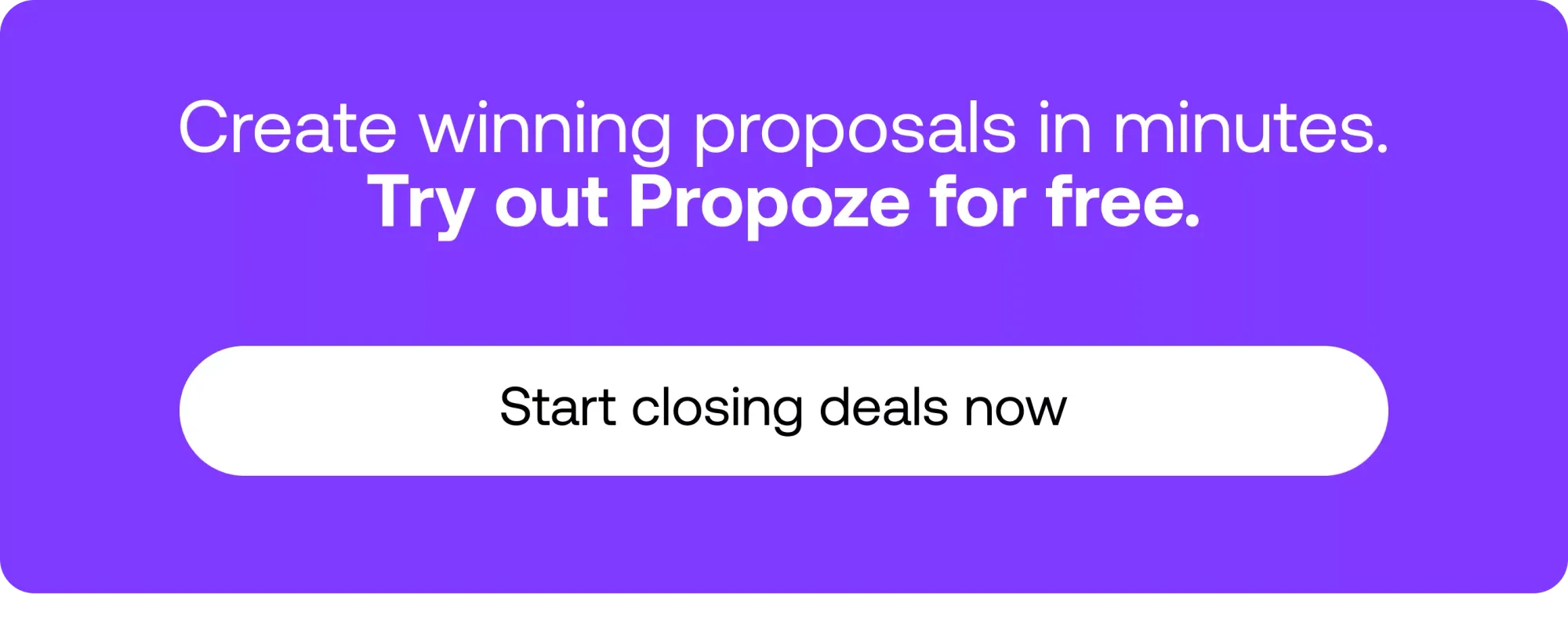
Proposal software helps enhance client experience
Proposal software plays a pivotal role in improving the client experience during onboarding by automating processes and ensuring seamless communication. It allows businesses to provide personalized, efficient, and engaging proposals that leave a lasting impression.
A key benefit is the professionalism that proposal software brings. Clients receive sleek, customized proposals that align with your brand, ensuring a consistent and polished experience. Automation also ensures that these proposals are sent on time and free from errors.
- Seamless, automated delivery: Proposals are sent promptly, reducing the risk of delays.
- Consistent branding: Templates ensure that every proposal reflects your business’s professional image.
Additionally, transparency and clarity are greatly improved. Proposal software allows you to clearly outline project terms, deliverables, and timelines, which reduces the need for back-and-forth communication.
- Clear expectations: Clients see all details upfront, reducing confusion.
- Less manual work: Fewer questions from clients mean less back-and-forth, saving time for both sides.
Interactive elements further enhance client engagement by allowing clients to interact with the proposal through dynamic pricing tables or embedded videos. These features make proposals more engaging, encouraging clients to stay involved in the process.
The speed and efficiency of proposal software is another major advantage. Clients appreciate quick responses, especially during onboarding, and automation ensures follow-ups and approvals happen without delays.
Finally, personalization at scale allows you to tailor each proposal to the individual client’s needs, thanks to CRM integration that pulls client-specific data into each proposal. This ensures every client feels understood, without extra manual effort.
By blending automation with personalized communication, proposal software makes the onboarding experience smoother, quicker, and more client-focused. This sets the foundation for building strong, long-term client relationships.
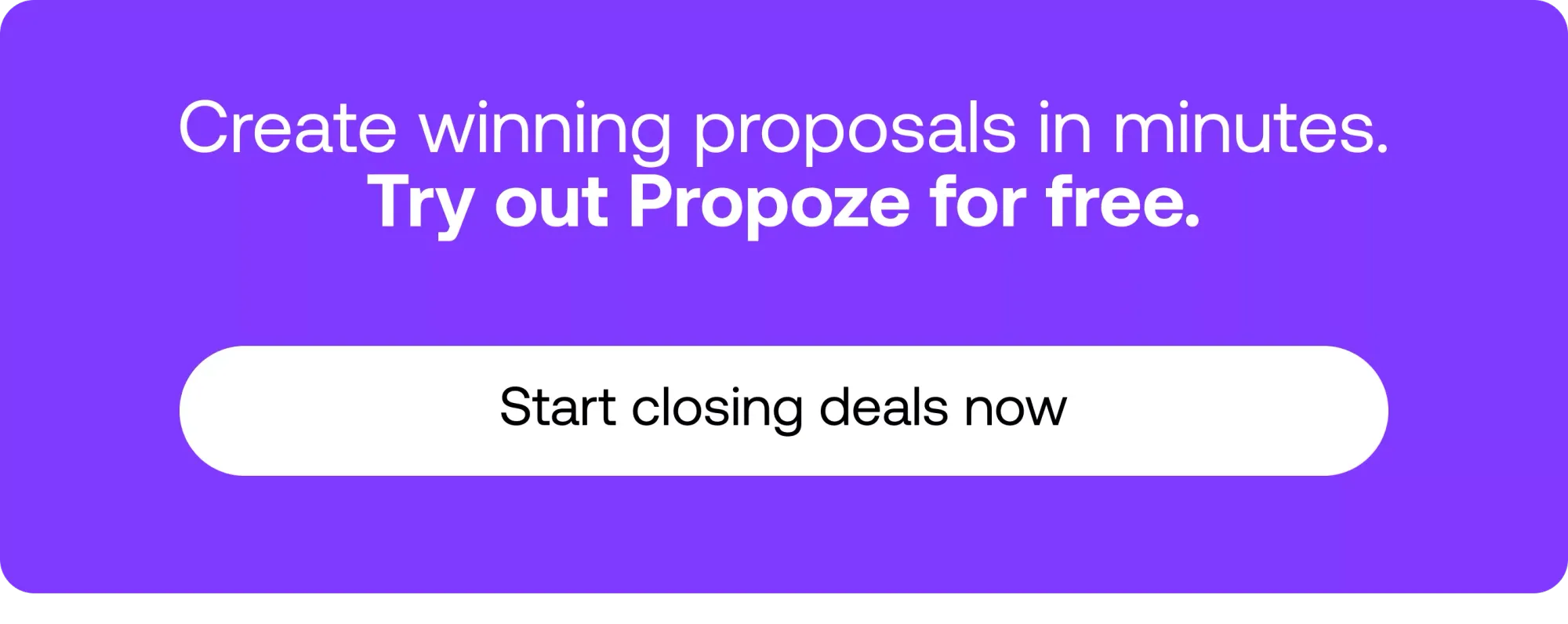
Personalized onboarding experience through proposals
A personalized onboarding experience is essential for building strong client relationships from the very beginning. Proposal software plays a key role in making this possible by tailoring each proposal to the specific needs, preferences, and goals of each client.
Tailoring content to client needs: Proposal software allows you to create customized proposals that reflect the unique goals of each client. By pulling data from integrated CRM systems, the software ensures that each proposal includes the client’s preferences, previous interactions, and specific requirements. This means that clients receive proposals that feel relevant and personalized, increasing the likelihood of engagement and success.
- Client-specific solutions: Proposals can highlight specific challenges your client faces and offer tailored solutions.
- Relevant recommendations: By analyzing past interactions, the software can suggest the right products or services that are most suited to the client's needs.
Dynamic personalization: Unlike static proposals, modern software offers dynamic personalization features. Elements such as interactive pricing tables, optional add-ons, and customized project timelines allow clients to engage more deeply with the proposal and make decisions based on their specific preferences. This dynamic approach makes the proposal more than just a document—it becomes a tool for client collaboration.
Enhanced client experience: Personalized proposals enhance the overall client experience by showing clients that their specific needs are understood and valued. From custom messaging to personalized pricing, the proposal speaks directly to the client’s individual pain points and goals. This approach not only increases client satisfaction but also builds trust and credibility, making clients more likely to move forward with your business.
- Personalized messaging: Every section of the proposal reflects the client’s unique journey and how your business can specifically address their needs.
- Improved engagement: The more personal and relevant the proposal, the more engaged clients will be in the process.
Faster decision-making: A well-personalized proposal simplifies the client’s decision-making process. By providing a proposal that aligns perfectly with their expectations, needs, and goals, clients can make faster, more confident decisions, reducing delays in onboarding and ensuring a smoother transition into your service.
Personalizing the onboarding experience through proposals is key to fostering long-term client relationships. With each proposal tailored to their specific situation, clients feel valued, understood, and confident in your services. This personalized approach not only strengthens trust but also enhances the overall efficiency and success of the onboarding process.
How to choose the right proposal software to improve client onboarding
Choosing the right proposal software is critical to enhancing your client onboarding process. With so many options available, it’s essential to select a tool that fits your business’s unique needs while improving efficiency, personalization, and collaboration.
Here are key factors to consider when selecting proposal software that will best support a streamlined and successful onboarding process.
1. Ease of use and customization
Your proposal software should be user-friendly, allowing your team to quickly create, customize, and send proposals without a steep learning curve. Look for software with an intuitive drag-and-drop editor and customizable templates that reflect your brand’s identity and meet client-specific needs.
- Why it matters: A simple interface reduces the time spent on proposal creation, allowing teams to focus on more strategic aspects of client onboarding.
2. CRM integration
Proposal software that integrates seamlessly with your CRM system ensures that client data is automatically populated into proposals. This integration helps eliminate manual data entry, reduces errors, and keeps all client information up-to-date throughout the onboarding process.
- Why it matters: With CRM integration, you can personalize proposals at scale and maintain accuracy across platforms, saving time while improving client satisfaction.
3. Automation features
Automation is essential for speeding up the onboarding process. The right proposal software will offer automation for follow-ups, reminders, approvals, and even document generation. This ensures that every step of the onboarding journey happens on time, without manual oversight.
- Why it matters: Automation helps businesses manage large client volumes efficiently while maintaining consistent communication and avoiding delays.
4. Personalization capabilities
To truly enhance the client experience, your proposal software should allow for deep personalization. This includes tailoring proposals to individual clients based on their preferences, previous interactions, and needs. Look for software that enables dynamic elements like interactive pricing tables and customized messaging.
- Why it matters: Personalization fosters stronger client relationships by showing clients that their specific needs are valued and addressed from the start.
5. Collaboration and real-time updates
Team collaboration is key during onboarding. Your proposal software should allow multiple team members to work on a proposal simultaneously, with real-time updates and version control. This ensures that everyone stays aligned on client expectations and that the proposal reflects input from all relevant stakeholders.
- Why it matters: Improved collaboration leads to higher-quality proposals and reduces miscommunication between internal teams, which can impact the onboarding process.
6. E-signature and approval tracking
Look for proposal software that offers built-in e-signature capabilities, allowing clients to approve proposals quickly and easily. Additionally, real-time tracking of proposal status—whether it’s viewed, signed, or pending approval—keeps your team informed of progress and next steps.
- Why it matters: E-signature functionality accelerates the approval process, helping to reduce onboarding delays and improve the overall client experience.
7. Scalability
If your business is growing or expecting to take on a larger volume of clients, ensure that the proposal software you choose is scalable. It should handle an increasing number of proposals, clients, and team members without sacrificing speed or functionality.
- Why it matters: Scalability ensures that as your business grows, your proposal and onboarding processes remain efficient and don’t become a bottleneck.
By considering these features, you’ll be able to choose the proposal software that best enhances your onboarding process, improves client relationships, and increases efficiency across the board.
7 best tools for automating proposals and onboarding
The right proposal software can dramatically enhance your onboarding process, providing automation, personalization, and seamless integration with other business tools. Below are some of the top tools for automating proposals and client onboarding:
1. Propoze
Propoze is designed to simplify proposal creation for small businesses and freelancers. It offers an intuitive drag-and-drop editor and customizable templates, allowing users to quickly create personalized proposals. The platform also includes real-time tracking, letting you monitor client interactions and engagement with proposals.
- Key features: Customizable templates, real-time client tracking, drag-and-drop editor.
- Best for: Small businesses and freelancers looking to streamline their proposal process.
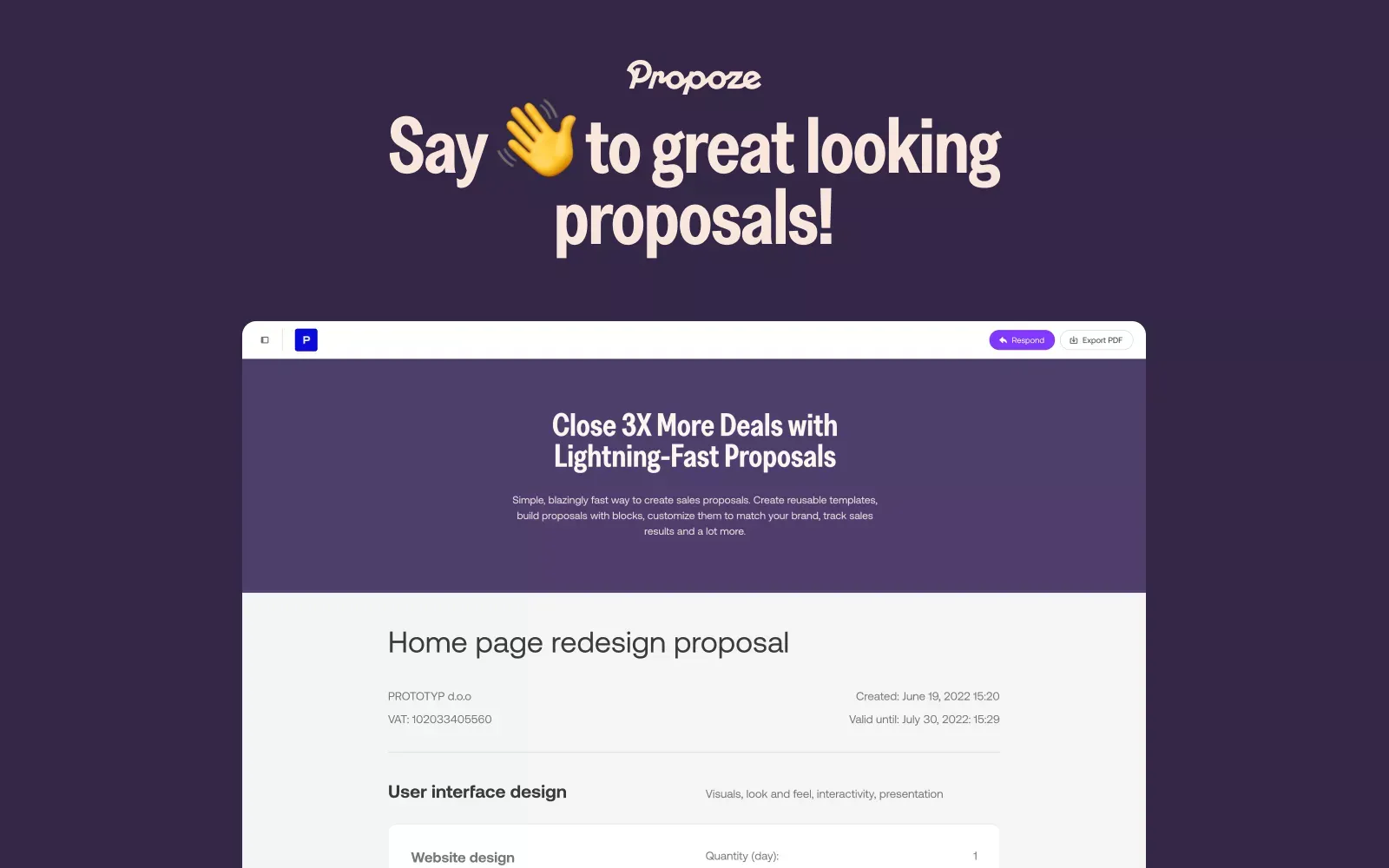
2. PandaDoc
PandaDoc is a robust tool that automates the entire proposal process, from document creation to e-signatures. Its integration with major CRM systems ensures that client data is auto-populated into proposals, saving time and reducing manual entry errors. PandaDoc also includes workflow automation, allowing you to set up automatic reminders and approvals to ensure nothing falls through the cracks.
- Key features: CRM integration, e-signatures, automated reminders, and workflow automation.
- Best for: Larger teams looking for a comprehensive document automation tool.

3. Qwilr
Qwilr stands out by transforming traditional proposals into engaging, interactive web pages. This tool allows businesses to create proposals that include multimedia elements like videos, dynamic pricing tables, and interactive features, which can enhance client engagement. Qwilr’s analytics feature tracks how clients interact with the proposals, providing valuable insights into client behavior.
- Key features: Interactive proposals, dynamic pricing, client engagement analytics.
- Best for: Creative professionals or businesses wanting to make a strong visual impact with their proposals.
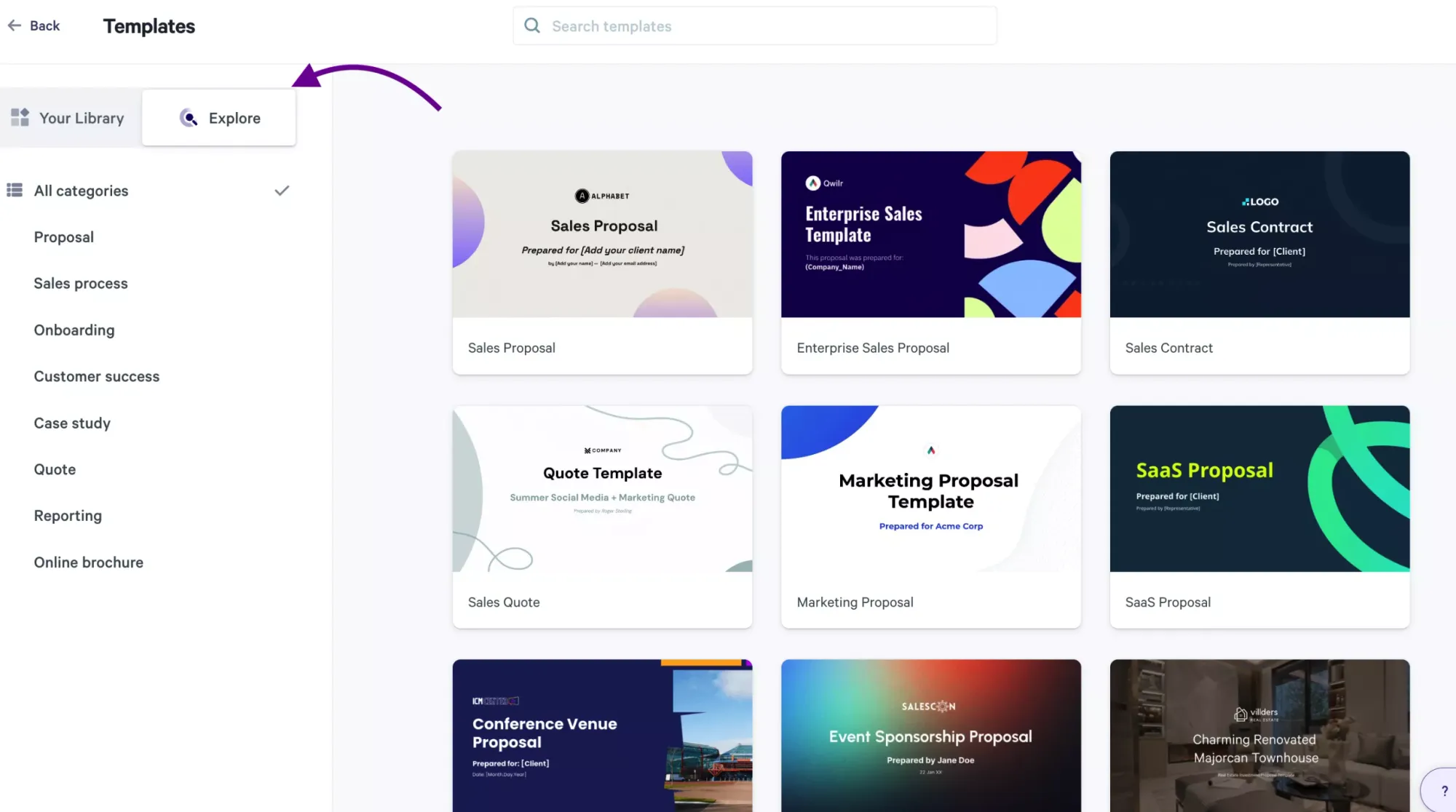
4. Proposify
Proposify streamlines proposal creation with a focus on team collaboration and brand consistency. Its template library helps businesses maintain a cohesive brand voice, while its collaboration tools allow team members to work together on proposals in real-time. The software’s analytics provide insights into which proposal sections clients are most engaged with, allowing you to optimize future proposals.
- Key features: Real-time collaboration, template library, detailed analytics.
- Best for: Teams needing collaboration and brand consistency in their proposals.
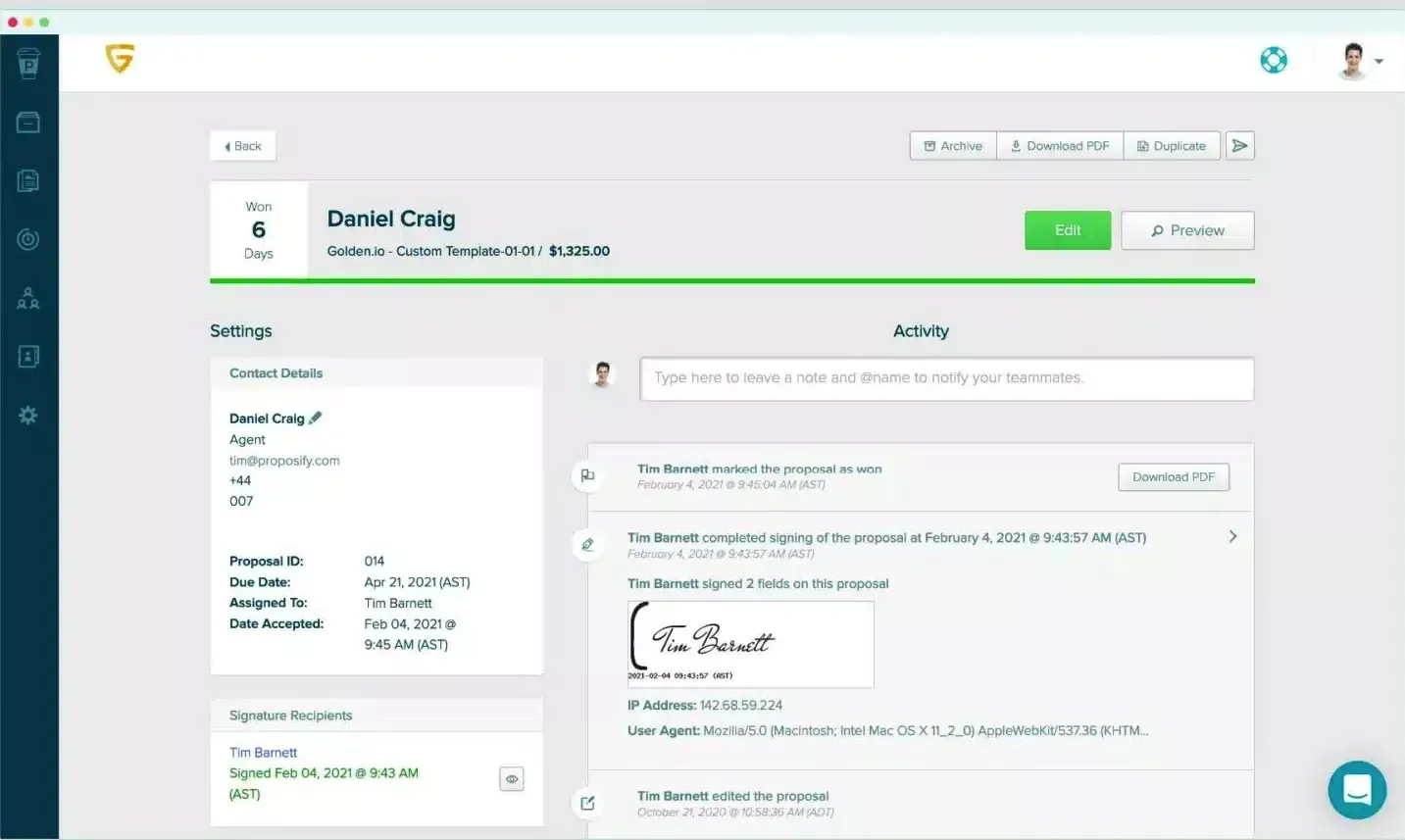
5. Better Proposals
Better Proposals simplifies the proposal process with pre-built templates and built-in e-signature functionality. It offers features like proposal tracking, payment integration, and one-click signatures, helping businesses close deals faster while reducing the time spent on administrative tasks.
- Key features: Pre-built templates, e-signatures, proposal tracking, payment integration.
- Best for: Freelancers and small businesses seeking quick proposal generation and fast deal closures.
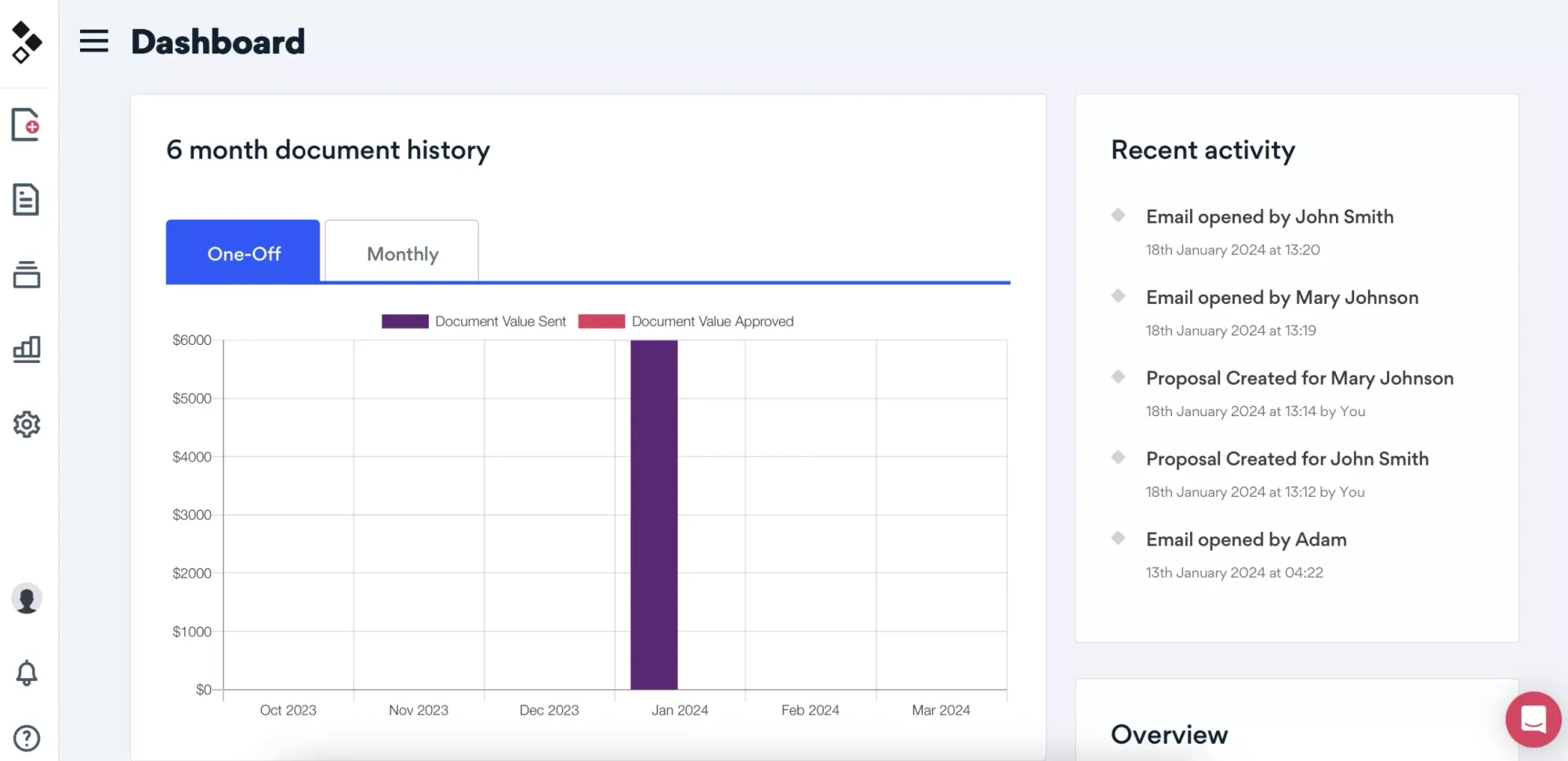
6. QuoteWerks
QuoteWerks is tailored for businesses that need to create quotes and proposals quickly while maintaining accuracy and professionalism. It integrates with CRM and accounting software, helping streamline the transition from proposal to invoicing. The tool offers powerful customization options, allowing businesses to tailor proposals to their specific needs.
- Key features: CRM and accounting integration, customization options, fast quote generation.
- Best for: Businesses focused on sales quotes and proposals.
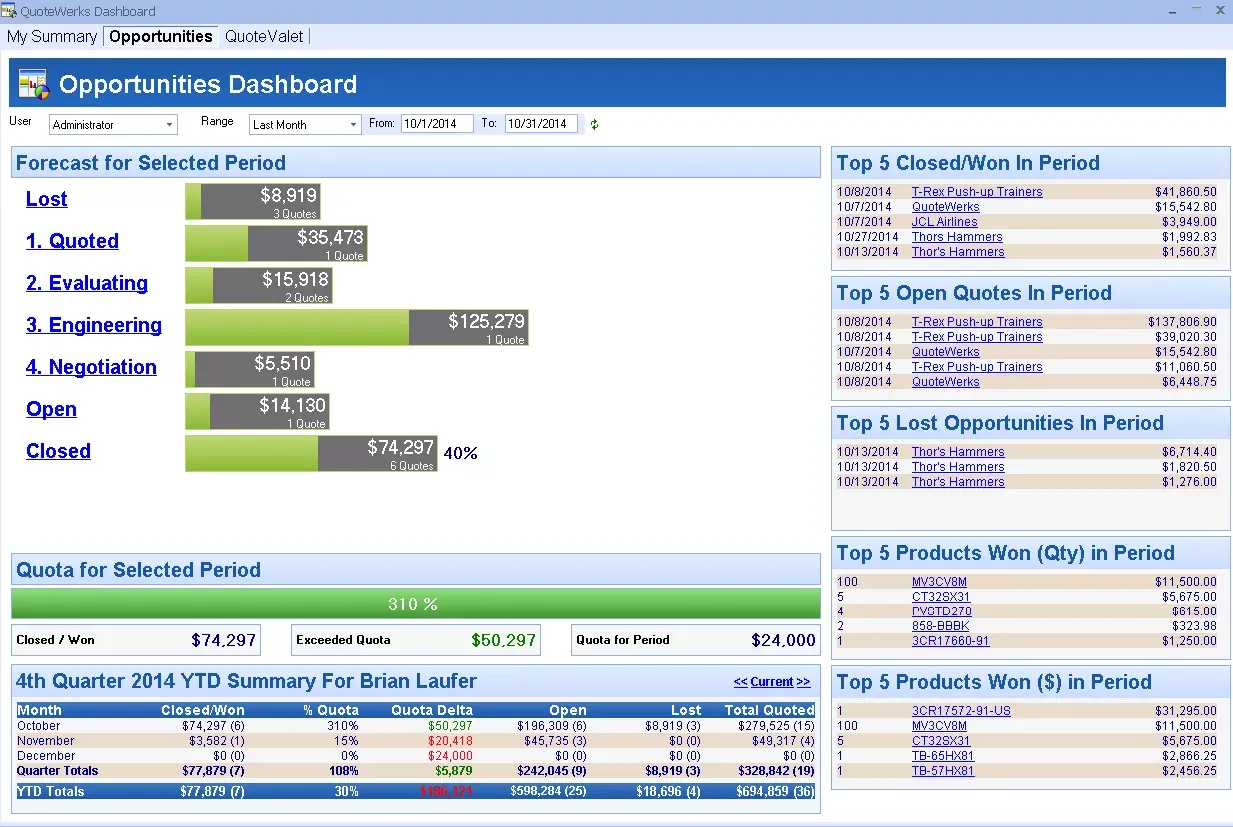
7. Nusii
Nusii is built for agencies and creative professionals, offering easy-to-use proposal templates and a streamlined interface. It automates follow-ups, helping users manage client communication without manual intervention. Nusii’s real-time analytics help track client interactions, providing insights into which proposals are most effective.
- Key features: Easy-to-use templates, automated follow-ups, real-time analytics.
- Best for: Agencies and creatives focused on delivering sleek, professional proposals.
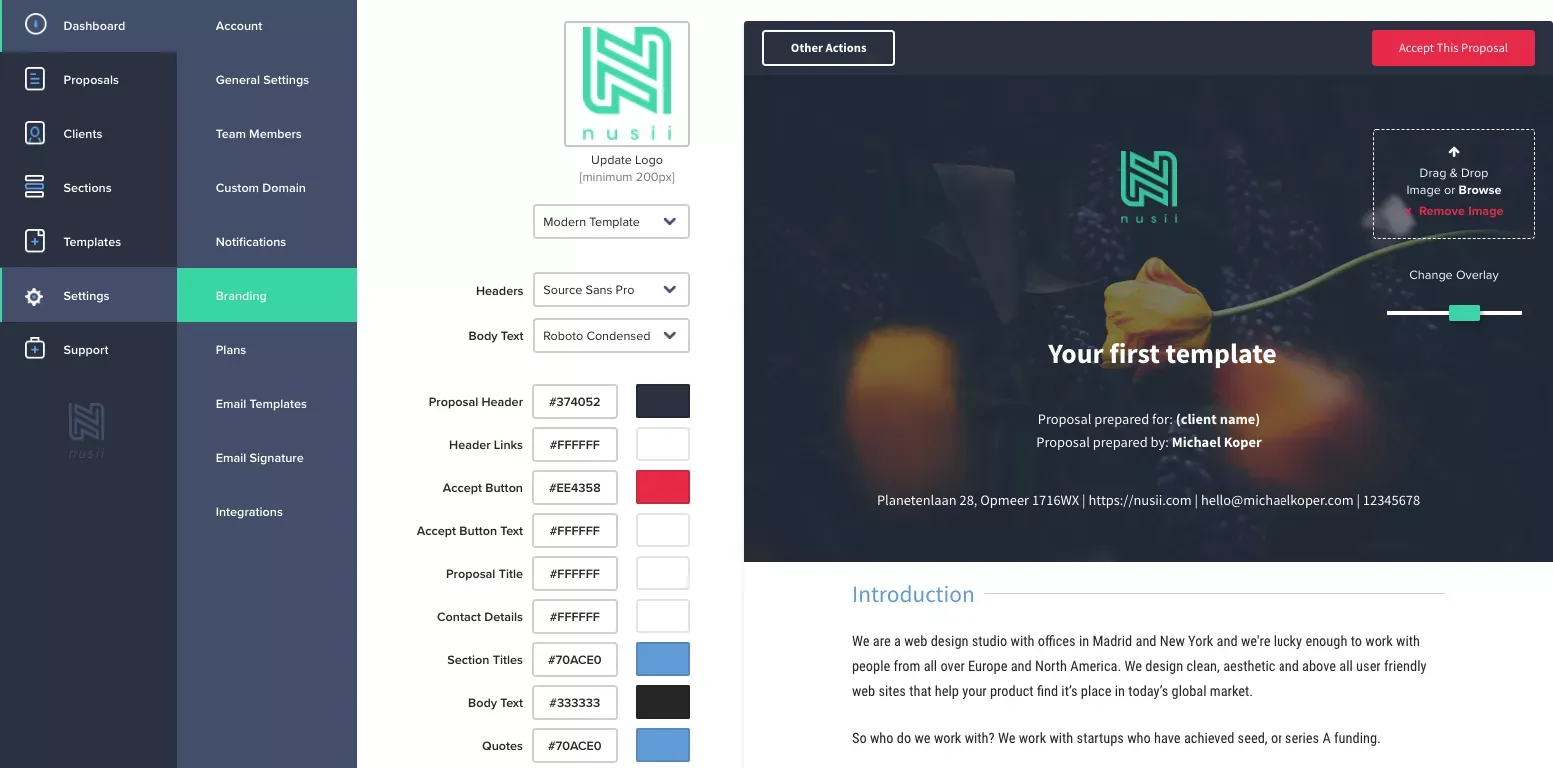
Transform your onboarding process with proposal software
Using proposal software to enhance your client onboarding process is no longer a nicety; it's a necessity.
Throughout this post, we've explored how automation, CRM integrations, and personalization can help streamline onboarding, minimize errors, and elevate the client experience. By leveraging the right tools, you can save time, maintain a high level of professionalism, and scale your business with much more ease.
Here are some main points we want to recap:
- Automating the workflow, saving time, and reducing manual effort during onboarding.
- Integrations with CRM systems to assure accuracy in data with personalized proposals.
- Applying the collaboration capabilities of the proposal software to amplify productivity in teams and maintain consistent levels of high-quality customer experiences.
At Propoze, we're committed to helping businesses transform their proposals and onboarding process with user-friendly, customized tools. If you're ready to take it to the next level, we invite you to try Propoze today for free and streamline your client experience.
For anything you might need, just let us know! We're always ready to help out.